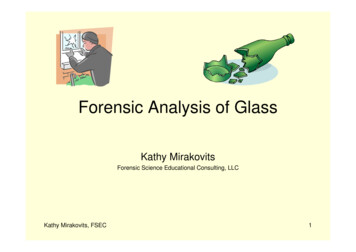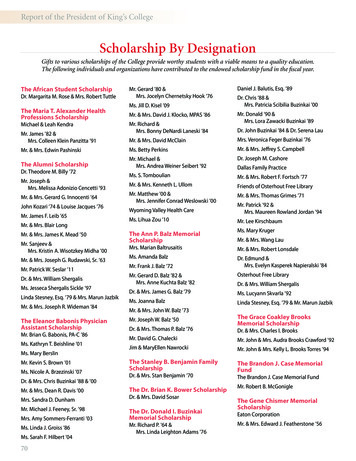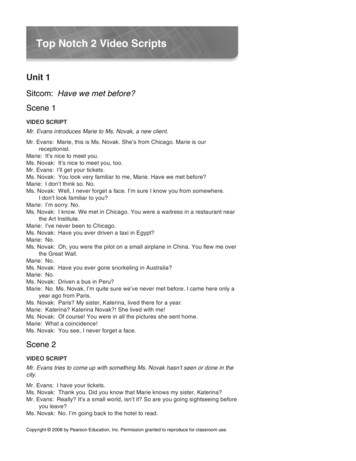
Transcription
Forensic Analysis of GlassKathy MirakovitsForensic Science Educational Consulting, LLCKathy Mirakovits, FSEC1
Glass An amorphous solid In pure form is made up of siliconand oxygen molecules:Silicon Dioxide- SiO2 High melting point - over 2000 0C Hard & brittle like a solidKathy Mirakovits, FSEC2
Types of Glass Float glass or soda lime glasswindows, picture frames, flatglass objects SiO2 with sodium carbonate(Na2CO3 and calcium oxide CaO) Tempered glass- safety glass,auto glass, shower doors andplate glass windows in store Same chemical makeup as sodalime glass, but top layer is cooledfirst causing internal stresses.When broken this glass fracturesinto small blunt pieces.Kathy Mirakovits, FSEC3
Types of Glass Borosilicate glass- labglassware, kitchen items(Pyrex) SiO2 with Boron Tinted glass- has colorants thatreduce glare / heat penetrationor for decorative use SiO2 with additives/colorants Leaded glass (crystal)- wineglasses, fine dining, figurines SiO2 with lead oxideKathy Mirakovits, FSEC4
Glass as Forensic Evidence Glass is forensically important It is found at most crime scenes It can be carried away from sceneundetected It is stable, does not decay As class evidence contributes to the pool ofevidence Important to collect proper knownsamples so incidental glass can beeliminatedKathy Mirakovits, FSEC5
Fracture Match Glass generally class evidence, except when afracture match is found, which is considered tobe an individual characteristic Microscopic characteristics can assist inmaking decision about suspected match Random stress patterns and breaks areuniqueReassembledMolotov CocktailThe vertical white linesare stress marks in twoeyeglass lenses. Noticehow the stress marksalign, an individualcharacteristic.Kathy Mirakovits, FSEC6
Analyzing Broken Glass Broken glass analysis is forensically important tothe reconstruction of events in a criminal act Analysis can include: The sequence of the fractures – order of events The direction of the force which caused the fracture –did the break occur from the inside or outside The identity (type) of a small piece of glass – sodalime glass, borosilicate, tempered, or lead crystalKathy Mirakovits, FSEC7
Sequencing Fractures Fracture lines: Radial and Concentric Radial fracture lines occur first extending outward from the breakpoint, produced when the opposite side of impact fails first Concentric fracture lines form a circle about the break point andare produced by the side of impact failing firstConcentricFracturesABKathy Mirakovits, FSECRadialFractures8
Sequencing Fractures Radial lines always end in existing radial lines Order in photo: A then B then CABKathy Mirakovits, FSECC9
What Are ThePossible Fracture Sequences?It can be noted:B was firstDBC was after EE was after AD was after BPossible Sequences:B, D, A, E, CB, A, D, E, CACB, A, E, D, CB, A, E, C, DEKathy Mirakovits, FSEC10
Direction of Force Small projectiles entry-exit Entry: smaller hole, smoothsurface Exit: wider hole, cratershape, rough surfacecratering Radial fractures indicatedirection of force 3R Rule: Radial fracture Right angle Reverse side of forceForce came from this sideEntryHoleKathy Mirakovits, FSECExitHoleRight Angle side11
Class Characteristic of Glass Class characteristics of glass are limited because glassis so inert—difficult to dissolve in solvents Exception is the Inductively Coupled Plasma MassSpectrometer (ICP/MS)—digests glass and performselemental analysis to determine chemical composition ICP/MS in few crime labs Most labs can analyze class characteristics: Physical appearance – size, shape, thicknessColorDensityRefractive indexKathy Mirakovits, FSEC12
Measuring The DensityOf A Small Piece of Glass1.2.3.Mass the piece of glass.Find Volume of glass.a. Tare beaker with water.b. Tie thread around glass.c. SUSPEND the glass in water.d. Take mass reading.e. Mass of water displaced Volume of water displaced Volume of piece of glass.Calculate density of the glass.Window Glass 2.53-2.54 g/mlPyrex Glass2.29-2.39 g/mlLeaded Glass 2.65-2.72 g/mlKathy Mirakovits, FSEC13
Refractive Index Refractive Index (RI) is the ratio of the velocity of light in avacuum to it’s velocity in a mediumc 3 x 108 m/s Equation:RI c/vmedium As light passes from one medium to a different medium,it changes speed, causing it to bend or refractThe strawappearsbent due torefractionof lightKathy Mirakovits, FSEC14
Refractive Index Determination of aSmall Glass Fragment Refractive index of small pieces of glass can bedetermined using commercially available liquids whoserefractive indexes are knownABCPhoto A shows a small piece of Pyrex glass not immersed in a liquid.Photo B shows the same piece of glass immersed in water.Photo C shows the piece immersed in vegetable oil. Pyrex and vegetable oil havesimilar indices of refraction as shown by the disappearance of the glass in the oil.Kathy Mirakovits, FSEC15
Refractive Index Determinationof a Small Glass FragmentGlass TypeWindow Glass (soda lime)PyrexTempered Glass (auto)Leaded Glass (29%-55%)Liquid MediumWaterVegetable OilClove OilKathy Mirakovits, FSECRI1.511.471.521.57-1.67RI1.331.471.5316
Measure the RI of Comparison Liquids Use plastic dishes filled with liquidto be tested Laser light or light box singlebeam through liquid at a givenangle (300). Trace refracted beam. Calculate RI using Snell’s Lawn1 n2(sin θ2) / sin θ1Kathy Mirakovits, FSECn2 1.00 (air)17
Forensic Analysis of Glass Kathy Mirakovits Forensic Science Educational Consulting, LLC. Kathy Mirakovits, FSEC 2 Glass An amorphous solid In pure form is made up of silicon and oxygen molecules: Sil










